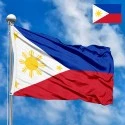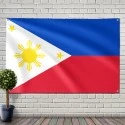The National Flag of the Philippines is a vibrant and deeply symbolic emblem that tells the compelling story of a nation's struggle for independence, its hard-won liberty, and its enduring aspirations for peace and progress. More than just a national banner, it is a powerful visual representation of the Filipino spirit, embodying historical sacrifices, democratic ideals, and the rich cultural tapestry of the archipelago. Its unique design, with its shifting display based on circumstances, makes it one of the most intriguing flags in the world.
A Visual Symphony: Description, Dimensions, and Element Arrangement
The Flag of the Philippines is characterized by its horizontal bicolour design of royal blue and crimson red, with a white equilateral triangle at the hoist. At the center of the white triangle is a golden sun with eight main rays, each ray representing one of the eight provinces (Manila, Cavite, Bulacan, Pampanga, Nueva Ecija, Tarlac, Laguna, and Batangas) that initiated the 1896 Philippine Revolution against Spanish colonial rule. In each corner of the white triangle, there is a golden five-pointed star, symbolizing the three main island groups of the Philippines: Luzon, Visayas, and Mindanao.
The colors of the flag hold profound meaning:
-
The royal blue stripe traditionally signifies peace, truth, and justice.
-
The crimson red stripe stands for patriotism and valor.
-
The white equilateral triangle represents liberty, equality, and fraternity, harking back to revolutionary ideals.
A unique feature of the Philippine flag is its ability to indicate a state of war. When the nation is at peace, the blue stripe is positioned at the top (or left, when hung vertically). However, in times of war, the red stripe is placed at the top (or left), serving as a powerful visual declaration of the country's readiness to defend its sovereignty.
While official guidelines provide for specific constructions, the most common ratio for the flag's width to length is 1:2. The precise placement of the sun and stars within the triangle, and the division of the field into two equal horizontal stripes, ensure visual balance and maintain the integrity of its symbolic elements. The golden elements are usually a bright, radiant yellow, providing a striking contrast against the primary colors.
Echoes of Time: The History of the Flag's Creation
The genesis of the Philippine Flag is deeply intertwined with the nation's fight for independence from Spain in the late 19th century. The flag was designed by General Emilio Aguinaldo, the first President of the Philippine Republic, during his exile in Hong Kong in 1897. He conceived the design as a symbol of the aspirations and ideals of the Filipino revolutionaries.
The flag was sewn by Marcela Agoncillo, Lorenza Agoncillo, and Delfina Herbosa de Natividad in Hong Kong. It was first unfurled and officially proclaimed as the national flag on June 12, 1898, during the proclamation of Philippine Independence at Aguinaldo's ancestral home in Kawit, Cavite. This historic moment marked the culmination of decades of revolutionary struggle against Spanish colonial rule.
However, the flag's journey was not without challenges. During the Philippine-American War (1899-1902), the display of the Philippine Flag was outlawed by the American colonial government under the Sedition Act of 1907. It remained suppressed for years, a testament to its powerful revolutionary symbolism. The ban was finally lifted with the passage of the Flag Law (Act No. 2871) in 1919, allowing Filipinos once again to proudly display their national emblem.
Throughout the American colonial period and World War II, the flag continued to be a potent symbol of national identity and the longing for full sovereignty. Upon gaining full independence from the United States on July 4, 1946, the same flag was officially adopted as the flag of the independent Republic of the Philippines. Its design has remained largely unchanged since its conception by Aguinaldo, signifying continuity and reverence for its revolutionary origins. The current specifications are enshrined in Republic Act No. 8491, also known as the "Flag and Heraldic Code of the Philippines," enacted in 1998.
The Philippines' Identity Woven in Fabric: Significance for the Nation
The Filipino Flag holds profound significance for the nation, embodying its hard-won freedom, national unity, and democratic aspirations. It is a constant reminder of the sacrifices made by national heroes and revolutionaries who fought for the country's sovereignty. The sun's rays represent the illuminating path to progress and development for all regions.
For the Filipino people, the flag is a source of immense national pride and identity. It symbolizes their unique resilience, their enduring spirit, and their unwavering love for their homeland. The flag is prominently displayed during national holidays, civic events, and everyday life, fostering a deep sense of patriotism and collective identity among citizens. It represents the collective spirit of a people who value liberty, justice, and equality, striving for a prosperous and harmonious future for all Filipinos. The unique "war flag" display also signifies the nation's readiness to defend its cherished values, underscoring the deep commitment to national defense.
Intriguing Facets: Interesting Facts about the Philippine Flag
-
The War Flag: The Philippine Flag is the only national flag in the world that is displayed differently in times of peace and war, with the red stripe at the top during conflict.
-
Designed in Exile: General Emilio Aguinaldo designed the flag while in exile in Hong Kong, reflecting the clandestine nature of the revolutionary movement.
-
Sewn by Women: The flag was meticulously sewn by a group of Filipino women in Hong Kong, highlighting the role of women in the independence movement.
-
First Unfurling: It was first unfurled on June 12, 1898, during the proclamation of Philippine Independence, a date now celebrated as "Independence Day."
-
Eight Rays, Eight Provinces: The eight rays of the sun specifically represent the eight provinces that first rose in revolt against Spanish rule in 1896, making the flag a historical document in itself.
-
Three Stars, Three Island Groups: The three stars represent Luzon, Visayas, and Mindanao, signifying the geographical unity of the archipelago.
-
Brief Ban: The display of the flag was banned by the American colonial government from 1907 to 1919, a period when its powerful symbolism was deemed a threat to colonial rule.
-
Specific Shade of Blue: The "royal blue" (or "navy blue") has a specific shade, often causing debate and re-specifications to ensure consistency, showcasing the precision in its design.
-
Inspired by US and Cuba: The triangular hoist and stripes are thought to be inspired by the flags of the United States (Aguinaldo admired American ideals) and the Cuban flag (another nation fighting for independence from Spain).
The Moment of Formalization: Adoption and Reception
The initial and most significant moment of adoption for the Philippine Flag occurred on June 12, 1898, when it was unfurled during the proclamation of Philippine Independence in Kawit, Cavite. At this historical juncture, it was symbolically recognized as the national flag of the fledgling First Philippine Republic. This event was met with fervent nationalistic zeal and profound joy by the Filipino revolutionaries and the populace eager for self-rule.
Following the Philippine-American War and the subsequent American colonial rule, the flag's public display was suppressed. However, its symbolic power never waned. The formal legal adoption of the flag in its current design for the independent republic occurred on July 4, 1946, the day the Philippines gained full sovereignty from the United States. This was a re-affirmation of the flag's original intent and symbolism.
The contemporary specifications and guidelines for the flag's display, design, and proper respect are codified in Republic Act No. 8491, known as the "Flag and Heraldic Code of the Philippines," enacted on February 12, 1998. This act reinforces the flag's status as a revered national symbol and ensures its consistent and respectful use. The reception among Filipinos has consistently been one of deep reverence and pride, seeing it as the ultimate embodiment of their nation's identity, sacrifices for freedom, and democratic values.
A Beacon of Identity: Meaning for Residents
For the people of the Philippines, the flag is a living, breathing symbol of their identity, history, and collective aspirations. It evokes a strong sense of patriotism, unity, and resilience. The vibrant colors and distinct elements speak volumes: the blue reminds them of peace and justice, the red of the courage and sacrifices made by their ancestors, and the white triangle of the purity of their democratic ideals and their unwavering commitment to liberty.
The golden sun and its eight rays serve as a powerful reminder of the enlightenment and progress sought by their forebears, connecting them to the very genesis of their nation. The three stars represent the geographical unity of the archipelago, fostering a sense of belonging across diverse islands and cultures. More profoundly, the unique "war flag" display instills a sense of responsibility and readiness to protect their sovereignty. When Filipinos see their flag, whether waving proudly over a school or displayed during a national celebration, it ignites a deep feeling of national pride and a shared sense of purpose, uniting them under a single, cherished emblem that truly represents the heart and soul of the Filipino nation.
In the demonstration images, full-size flags are shown with proportions of 2:3, and hand-held flags with proportions of 1:2.






 Waving flag
Waving flag
 Sizes:
Sizes:
 Round flag
Round flag
 Sizes:
Sizes:
 Rectangular flag 2:3
Rectangular flag 2:3
 Sizes:
Sizes: